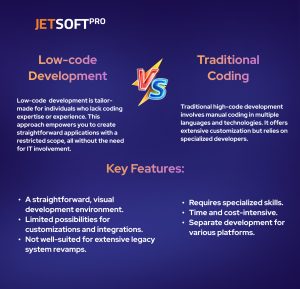In the ever-evolving landscape of technology startups, the need for rapid development, cost efficiency, and accessibility to non-technical founders has never been more pronounced. Enter low-code development platforms, a game-changer that is transforming how startups bring their innovative ideas to life. This article will explore the emergence and impact of low-code development in the startup ecosystem.
The Start-up Landscape
- The Proliferation of Startups
Startups have become a driving force in the global economy, fueled by entrepreneurial spirit and disruptive ideas. They are not just creating innovative products and services; they are reshaping industries. However, in this competitive environment, speed is often the essence. Startups must get their ideas off the ground quickly to gain a competitive edge.
- The Need for Rapid Development
Traditional software development can be time-consuming and resource-intensive, which can pose a significant challenge for startups. Time-to-market is critical, and any delays can be detrimental. This is where low-code development comes into play.
- The Resource Challenge
Startups often face resource constraints. They may not have large development teams or extensive budgets. Low-code development offers an elegant solution, allowing startups to do more with less.
What is Low-Code Development?
Low-code development is a visual approach to software development that enables users to create applications with minimal hand-coding and manual programming. Instead, developers use graphical interfaces and pre-built components to design, build, and deploy applications quickly.
How Low-Code Differs from Traditional Coding
Low-code development streamlines the development process by abstracting much of the complex coding work. It is not a replacement for traditional coding but rather a complementary approach that accelerates development.
The Benefits of Low-Code for Startups
- Cost Efficiency: Low-code reduces the need for extensive development teams, saving on personnel costs.
- Speed of Development: Rapid prototyping and development mean startups can get their products to market faster.
- Accessibility to Non-Technical Founders: Founders with limited technical knowledge can actively participate in the development process.
- Scalability and Flexibility: Low-code platforms often support scalability, adapting to a startup’s growth.

The Appeal of Low-Code for Startups
- Cost Efficiency
Startups operate under stringent financial constraints, often allocating their resources judiciously to ensure longevity. Low-code development emerges as a cost-effective solution, significantly reducing the expenses associated with hiring a large development team or purchasing extensive software licenses. By leveraging pre-built components and streamlined development processes, startups can allocate their precious financial resources strategically, focusing on other critical aspects of business growth such as marketing or product iteration.
- Speed of Development
In the relentless race for market share and customer attention, startups thrive on speed. The rapid development capabilities of low-code platforms align perfectly with the startup ethos. Traditional coding can be time-consuming, with projects spanning months before seeing the light of day. Conversely, low-code platforms facilitate swift ideation, prototyping, and deployment. Notably, a Forrester study has illuminated the profound impact of low-code on development timelines, revealing that projects executed with low-code methods can progress up to 20 times faster than those reliant on traditional coding approaches. This monumental time savings can be the difference between capturing a market opportunity and lagging behind the competition.
- Accessibility to Non-Technical Founders
The entrepreneurial spirit knows no bounds, and many startup founders hail from non-technical backgrounds. For these visionary leaders, low-code development serves as a gateway to actively participate in the creation of their digital products. By providing a user-friendly, visual development environment, low-code platforms bridge the gap between ideas and execution, enabling non-technical founders to articulate their visions clearly. This accessibility democratizes the development process, fostering collaboration between technical and non-technical team members, and ensuring that the product’s core vision remains intact.
- Scalability and Flexibility
Startups often embark on their journey with a small but ambitious user base. As they gain traction and expand their reach, the ability to scale swiftly becomes paramount. Low-code platforms, designed with scalability in mind, empower startups to grow without the growing pains. They offer the flexibility to adapt applications to changing market conditions, accommodate surges in user demand, and seamlessly integrate new features. This adaptability ensures that startups remain agile and responsive, allowing them to pivot when necessary and capitalize on evolving market trends.
In essence, the appeal of low-code for startups transcends its ability to mitigate budgetary constraints and expedite development. It embodies a transformative force, equipping startups with the tools needed to innovate swiftly, embrace non-technical founders as active contributors, and navigate the dynamic path to scalability and success in the competitive startup landscape.
Challenges and Limitations
Security Concerns
While low-code development is celebrated for its rapidity and accessibility, it does raise legitimate concerns regarding data security. Startups must prioritize addressing these challenges to safeguard sensitive information. Some key considerations include:
- Data Encryption: Ensure that data transmitted and stored within low-code applications is encrypted. This safeguards data from unauthorized access during transmission and while at rest.
- Authentication and Authorization: Implement robust authentication and authorization mechanisms to control access to sensitive information. This includes role-based access control to restrict data access to authorized users only.
- Compliance: Be aware of industry-specific regulations and compliance requirements, such as GDPR for data privacy. Ensure your low-code applications adhere to these standards to avoid legal ramifications.
- Vendor Security: Evaluate the security measures employed by your chosen low-code platform provider. Verify that they follow industry best practices for securing their infrastructure and services.
- Monitoring and Auditing: Implement continuous monitoring and auditing processes to detect and respond to security threats promptly. This proactive approach can mitigate potential risks.
We recommend that you take a look at our earlier article, “Fortifying the Code: A Startup’s Guide to Building Secure Software Solutions,” for a more in-depth exploration of code security issues and strategies to address them.
Customization Constraints
While low-code platforms excel in speed and efficiency, they may not always align with the need for highly customized solutions. Startups should carefully assess their requirements and expectations in this regard:
- Scope Analysis: Before selecting a low-code platform, thoroughly analyze your project’s scope. Determine whether the application’s functionality can be adequately met within the platform’s constraints or if custom coding is necessary for specific components.
- Hybrid Approaches: Consider hybrid development strategies that blend low-code with traditional coding. This approach allows you to leverage the advantages of both worlds, providing the flexibility to customize critical elements while benefiting from low-code efficiency for others.
- Future Scalability: Think long-term. Assess whether a highly customized solution will hinder your application’s scalability or create maintenance challenges down the road. Strive for a balance between customization and scalability.
Integration Complexity
Integrating low-code applications with existing systems and third-party services can indeed pose complexity. To ensure seamless integration, startups should adopt a strategic approach:
- API Compatibility: Verify that the low-code platform provides robust support for integrating with APIs. APIs serve as connectors to other systems and are vital for data exchange and functionality expansion.
- Legacy Systems Evaluation: Thoroughly evaluate your existing systems. Identify potential bottlenecks or compatibility issues that may arise during integration. Consider whether any legacy systems need updates to facilitate smoother integration.
- Documentation and Testing: Prioritize comprehensive documentation and rigorous testing during the integration process. This ensures that data flows correctly, and the application functions as expected when integrated with external systems.
- Expertise: If integration complexity is a concern, consider bringing in experts or consulting with professionals who specialize in low-code integration. Their expertise can streamline the process and reduce potential roadblocks.
Prioritizing security, carefully assessing customization needs, and planning for integration complexity are essential steps toward harnessing the full potential of low-code development while mitigating potential pitfalls.
Selecting the Right Low-Code Platform
Choosing the Right Low-Code Platform for Your Startup
Low-code platforms have emerged as indispensable tools for startups seeking to streamline their development processes and swiftly materialize innovative concepts in the market. However, the decision of selecting the most suitable low-code platform bears immense significance for ensuring the success of your startup. This article sheds light on the critical aspects of making this pivotal choice.
The Importance of the Right Choice
Selecting the ideal low-code platform is a pivotal decision for startups aspiring to expedite development and foster innovation. By meticulously considering factors such as scalability, security, and user-friendliness, examining prominent platform options, and adhering to best practices, startups can effectively unlock the full potential of low-code development. This, in turn, propels their growth and secures a competitive edge in the dynamic tech landscape.
Exploring Platform Options
To make an informed decision, startups should delve into the landscape of popular low-code platforms and discern their unique strengths:
- Appian: Acknowledged for its robust workflow automation capabilities, Appian excels in applications centered around processes. It offers a low-code platform designed to scale and adapt flexibly.
- OutSystems: Renowned for its comprehensive approach, OutSystems provides a visual development environment with a strong emphasis on mobile and web app creation. Its reputation is bolstered by its swiftness and user-friendliness.
- Mendix: Promoting collaboration, Mendix offers a platform rich in app lifecycle management features. It proves invaluable for startups seeking a cohesive teamwork-oriented approach to development.
- Microsoft Power Apps: For startups embedded in Microsoft’s ecosystem, Power Apps offers seamless integration with other Microsoft tools. This makes it a compelling choice for enhancing existing workflows.
- Salesforce Lightning: Tailored for businesses focused on customer relationship management, Salesforce Lightning furnishes low-code tools for crafting and customizing CRM applications.
Implementing Successfully
The implementation of a low-code platform is the linchpin in realizing its benefits. Startups should pay heed to these best practices:
- Training: Commit to training your team to harness the platform’s capabilities to the fullest. This not only ensures efficient utilization but also stimulates innovation.
- Starting Small: Launch your low-code journey with a modest project to acquaint your team with the platform. As confidence burgeons, gradually take on more intricate tasks.
- Encouraging Collaboration: Foster a culture of collaboration between technical and non-technical team members. This diversity of expertise can yield more inventive solutions.
- Regular Updates: Keep your platform and applications up-to-date by applying the latest features and security patches supplied by the platform provider.
- Feedback Loop: Establish a systematic feedback mechanism to glean insights from users. This ongoing refinement process amplifies the quality of your applications over time.
If you’re still contemplating what low-code entails and how to incorporate it into your product, especially if you lack technical expertise, now might be the ideal moment to consider partnering with a software development company. Such a partnership can help mitigate risks and guide you in selecting the appropriate platform to expedite your product’s market entry. Feel free to take a brief glance at our article for further insights: The Advantages of Outsourcing Software Development for Startup Businesses.
Future Trends
- Evolving Low-Code Capabilities
The evolution of low-code development is an exciting prospect for startups. These platforms are continually enhancing their capabilities to empower businesses further. In the near future, startups can anticipate:
Advanced Visual Development: Low-code platforms will provide even more intuitive visual development environments. This will allow users to design and build complex applications with greater ease, reducing the learning curve for new developers.
Integration with Emerging Technologies: Expect low-code platforms to seamlessly integrate with emerging technologies like augmented reality (AR) and virtual reality (VR), enabling startups to create cutting-edge applications in these rapidly growing fields.
Enhanced Mobile App Development: Mobile app development will become even more efficient and feature-rich within low-code environments. Startups will have the tools to create mobile apps that rival those produced by large, traditional development teams.
Deeper Analytics Integration: Analytics and reporting features will be strengthened, providing startups with deeper insights into user behavior and application performance. This data-driven approach will be essential for making informed business decisions.

- Integration with AI and Machine Learning
The integration of low-code development with artificial intelligence (AI) and machine learning (ML) is a game-changer for startups. This fusion opens new realms of possibilities:
Automated Decision-Making: Low-code platforms will increasingly harness AI to automate decision-making processes within applications. This will lead to smarter, more adaptive software that can respond dynamically to user input and changing conditions.
Predictive Analytics: AI and ML integration will empower startups to incorporate predictive analytics into their applications. This means applications can anticipate user needs and provide personalized experiences, a significant advantage in today’s competitive markets.
Natural Language Processing (NLP): Startups can leverage NLP capabilities through low-code platforms to create conversational AI applications, chatbots, and virtual assistants. These tools will enhance customer engagement and streamline support processes.
Enhanced Data Insights: Machine learning algorithms will enable startups to extract deeper insights from their data. This, in turn, will drive more effective decision-making, product refinement, and customer engagement strategies.
Our team has crafted a compelling article aimed at enhancing your comprehension of how machine learning is seamlessly integrated into the development of cutting-edge software solutions, thereby empowering startups to engineer innovative and robust software solutions that pave the way for success.
- Increasing Competition in the Low-Code Space
As low-code development gains prominence, the market is becoming increasingly competitive. For startups, this translates to several notable trends:
Diverse Platform Offerings: Expect to see a broader range of low-code platforms catering to various niches and industries. Startups will have more specialized tools to choose from to address their unique needs.
Innovative Pricing Models: To stay competitive, low-code providers may introduce innovative pricing models, making it more accessible for startups to adopt these platforms. This could include tiered pricing, pay-as-you-go options, or even free tiers with limited functionality.
Enhanced Ecosystems: Low-code providers will expand their ecosystems, integrating with a broader range of third-party tools and services. This will give startups more flexibility in their development and integration efforts.
Community and Support: As competition grows, expect low-code platforms to invest more in their user communities and support networks. Startups can benefit from a wealth of resources, knowledge-sharing, and troubleshooting assistance.
In conclusion, the future of low-code development is bright and promising for startups. Evolving capabilities, integration with AI and ML, and increased competition are poised to drive innovation and create opportunities for startups to excel in their development endeavors. Staying informed and adaptable will be key to harnessing these emerging trends effectively.
Conclusion
In conclusion, low-code development platforms are a rising force in the startup world. They offer an effective way to overcome resource constraints, accelerate development, and remain competitive. Startups should consider integrating low-code into their development strategies to unlock their full potential in this dynamic landscape.

